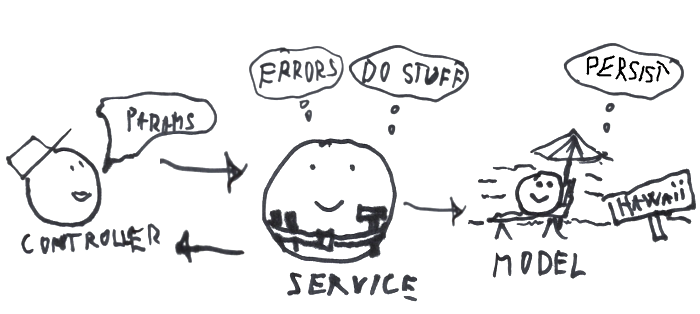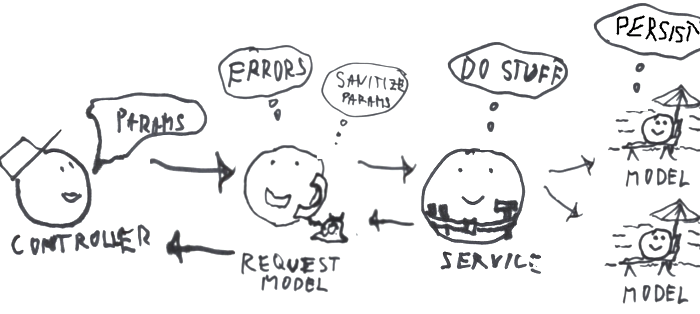Different ways how to do contextual Rails validations
ArticleLast weeks I stumble upon a discussion on “How to add validations to a specific instance of an active record object?” and I was trying to write an answer in few words yet that turned to this “short” article :)
Problem with Rails validations is that they are registered on a Class level not instance level.
This means that in ideal object world we could just do this:
# Reminder, This is not possible !!!
identity = Identity.new
identity.validations << ValidateEmailFormat.new(with: /\A[^@\s]+@([^@\s]+\.)+[^@\W]+\z/, on: :submitted_email)
identity.validators # => [#<ValidateEmailFormat ...>] # ...
…and therefore instance would just ask itself “what are the registered validators I have to apply”
But in reality our validators are registered when class is registered to the system:
class Identity < ActiveRecord::Base
validates_format_of :submitted_email, with: /\A[^@\s]+@([^@\s]+\.)+[^@\W]+\z
end
Identity._validators # {:submited_email=>[#<ActiveRecord::Validations::PresenceValidator:0x00000002258ff8 # ....
…and therefore instance is asking Class “what are the registered validators on you that I have to apply”
So if you try to register another validator, that will then reflect to all instances.
In remaining part of the article we will have a look on some alternatives how something similar can be done.
In our examples will be trying to solve this issue:
# app/models/identity.rb
class Identity < ActiveRecord::Base
# this should be validated all the time
validates_presence_of :uid, :provider, :auth
# this should be validated only in some cases
validates_presence_of :submitted_email
validates_format_of :submitted_email, with: /\A[^@\s]+@([^@\s]+\.)+[^@\W]+\z/
end
So we want to validate presence of :uid and :provider all the time (e.g.: model
update received via OAuthCallbackController#create), but we should validate :submitted_email
only when submitted from other controller when we prompt User to update
his record(Identities#update)
attr_accessor as a behavior modifier
One way would be to enable attr_accessor in our model and we would set some
value (without writing to DB) from a controller and deal with the condition inside the model:
# app/controllers/identities_controller.rb
class OAuthCallbackController
def create
@identity = Identity.new(params.slice(:uid, :provider))
if @identity.save # will validate only :uid, :provider
# ...
end
end
end
# app/controllers/identities_controller.rb
class IdentitiesController
def update
@identity = Identity.find(params[:id])
@identity.attributes(params.require(:identity).permit(:submitted_email))
@identity.editting_context = :interface
if @identity.save # will validate :uid, :provider and :submitted_email
# ...
end
end
end
# app/model/identity.rb
class Identity < ActiveRecord::Base
attr_accessor: :editting_context
validates_presence_of :uid, :provider, :auth
validates_presence_of :submitted_email, if: :interface_context?
validates_format_of :submitted_email, with: EMAIL_REXP, if: :interface_context?
def interface_context?
editting_context_interface == :interface
end
end
# or
# app/model/identity.rb
class Identity < ActiveRecord::Base
attr_accessor: :editting_context
validates_presence_of :uid, :provider, :auth
validates_presence_of :submitted_email,
if: Proc.new{|i| i.editting_context == :interface }
validates_format_of :submitted_email,
with: EMAIL_REXP,
if: Proc.new{|i| i.editting_context == :interface }
end
Problem is that this may easily get out of hand and your model will be too fat.

Rails built in on: context
Ruby on Rails has a build in way how to deal with this situations by introducing validation context.
# app/model/identity.rb
class Identity < ActiveRecord::Base
EMAIL_REXP = /\A[^@\s]+@([^@\s]+\.)+[^@\W]+\z
validates_presence_of :uid, :provider, :auth
validates_presence_of :submitted_email, on: :interface
validates_format_of :submitted_email, with: EMAIL_REXP, on: :interface
end
# app/controllers/oauth_callback__controller.rb
class OAuthCallbackController
def create
@identity = Identity.new
@identity.attributes(params.slice(:uid, :provider))
if @identity.save # will validate only :uid, :provider
# ...
end
end
end
# app/controllers/identities_controller.rb
class IdentitiesController
def update
@identity = Identity.find(params[:id])
@identity.attributes(params.require(:identity).permit(:submitted_email))
if @identity.save(context: :interface) # will validate :uid, :provider and :submitted_email
# ...
end
end
end
You can read more about validation contexts here:
The problem however is that this can get out of hand, and if your model is fat, it will make it even larger.
You could deal with this issue by using concerns
# app/model/concerns/interface_identity_concern.rb
module InterfaceIdentityConcern
extend ActiveSupport::Concern
included do
validates_presence_of :submitted_email, on: :interface
validates_format_of :submitted_email, with: EMAIL_REXP, on: :interface
end
end
# app/model/identity.rb
class Identity < ActiveRecord::Base
EMAIL_REXP = /\A[^@\s]+@([^@\s]+\.)+[^@\W]+\z
include InterfaceIdentityConcern
validates_presence_of :uid, :provider, :auth
end
But placing everything into Concerns is like putting all the mess into drawer when your Mom asks you to clean your room. It looks clean but the mess is still there and finding stuff when you need is difficult.
It also doesn’t solve the fact that you are basically using “hash map” for controlling you use cases (which is in 90% of cases ok) but you are not using can get quickly out of hands.

Let’s have a look on some Object Oriented Solutions.
If you are Ruby novice I’m recommending to stuck with existing conventions that were described above, topics bellow may feel too out of hand for untrained eye.
Validations on Decorator object
Another solution is to define validations on a Delegator object and then just “decorate” the Model you are trying to apply different set of validations:
Note if you are familiar with Draper gem meaning of the Decorator object decribed in this article is different. Decorator objects can wrap functionality around objects on different levels (in this case validation level) Draper is just really good implementation on decorating Models with View responsibilities.
# app/models/identity.rb
class Identity < ActiveRecord::Base
validates_presence_of :uid, :provider
end
# app/models/submitted_identity.rb
class SubmittedIdentity < SimpleDelegator
include ActiveModel::Validations
validates_presence_of :submitted_email
validates_format_of :submitted_email, with: /\A[^@\s]+@([^@\s]+\.)+[^@\W]+\z
def save
super if valid?
end
def update(*)
raise "don't use #update use #save"
end
def update_attributes(*)
raise "don't use #update_attributes use #save"
end
end
# app/controllers/oauth_callback_controller.rb
class OAuthCallbackController
def update
@identity = Identity.find(params[:id])
@identity.attributes = params.slice(:uid, :provider)
if @identity.save
# ...
end
end
end
# app/controllers/identities_controller.rb
class IdentitiesController
def update
@identity = Identity.find(params[:id])
@identity = SubmittedIdentity.new(@identity)
# @identity.class # => SubmittedIdentity
@identity.attributes = params.require(:identity).permit(:submitted_email)
if @identity.save
# ...
end
end
end

The biggest benefit is that you can stack several decorators like this and have different layers of validation
@identity = Identity.find(params[:id])
@identity = SubmittedIdentity.new(@identity)
@identity = SomeOtherValidationIdentityDecorator.new(@identity)
@identity = AndAnotherValidationIdentityDecorator.new(@identity)
# ...

This may seem as ideal solution however there are some big issues with this approach.
First of all you may stumble on the naming issue if you
do something like My <%= @identity.class.name %> in your views, as
your instance variable @identity is class SubmittedIdentity.
This should not be an issue if you do some name method delegation as a part of this class, but I don’t want to get too deep into that in this article. Point is there are ways how to get around limitations of this approach.
e.g.:
# app/model/submitted_identity.rb
class SubmittedIdentity < SimpleDelegator
# ...
def model_name
__getobj__.class.name
end
end
My <%= @identity.model_name %>
Another issue is that the @errors instance_variable is defined on the
instance level of the decorator class, meaning that the model and the
decorator has their own separate errors
This happens due to
include ActiveModel::Validationssource here
Therefore if you do:
@identity = Identity.new
@submitted_identity = SubmittedIdentity.new(@identity)
@identity.valid ? # => false
@submitted_identity.valid? # => false
@identity.errors.size # => 2 ...errors on :uid, :provider
@submitted_identity.errors.size # => 1 ...errors on :submitted_email
So the question really is if this is a bug or a feature for the particular usecase that you need. For example when submitting Rails form on a new Identity you don’t want to display errors on fields that are not shown in the input.
The “own errors” problem may be also an issue if you use some other Rails gem that is
forcing itself to communicate directly with model. For example if you use
Draper gem and you try to Draper Decorate our Validation Decorator
instance it
will not recognize the errors on Validation Decorator:
@identity = Identity.new(uid: 12345, provider: 'Twitter')
@submitted_identity = SubmittedIdentity.new(@identity)
@identity.valid ? # => true
@submitted_identity.valid? # => false
@draper_decorated_identity = @submitted_identity.decorate # drapers IdentityDecorator
@draper_decorated_identity.vaild? # true
@draper_decorated_identity.erros.size # 0
@draper_decorated_identity.object.class # Identity
As you can see Draper will decorate itself around underlying instance of
Identity not SubmittedIdentity
So in this case you need to have all the errors brought together you need something like this:
class SubmittedIdentity < SimpleDelegator
include ActiveModel::Validations
validates_presence_of :submitted_email
validates_format_of :submitted_email, with: /\A[^@\s]+@([^@\s]+\.)+[^@\W]+\z
def valid?
result = super
errors.each do |e|
__getobj__.errors.add e
end
result
end
def save
super if valid?
end
def update(*)
raise "don't use #update use #save"
end
def update_attributes(*)
raise "don't use #update_attributes use #save"
end
end
This will sync up errors from the SubmittedIdentity object to Identity
@identity = Identity.new(uid: 12345, provider: 'Twitter')
@submitted_identity = SubmittedIdentity.new(@identity)
@draper_decorated_identity = @submitted_identity.decorate
@draper_decorated_identity.vaild ? # false
@draper_decorated_identity.erros.size # 1
@draper_decorated_identity.object.class # Identity
Decorator Validation objects are handy and quick to introduce but you need to be really careful with them and really understand what is going on and write tests for the usecases, not only on Unit level but on integration level as they may backfire when a Junior Developer join your team.
Separate Validation object
Other way to deal with this is to have the validations on a separate
object. Basically your model will stay validation free and you call
valid? on external object. This way your for example your service object
holds the validations:
# app/model/identity.rb
class Identity < ActiveRecord::Base
# nice thin model doing other improtant model stuff
end
# app/services/oauth_identity_creator.rb
class OauthIdentityCreator
include ActiveModel::Validations
attr_accessor :uid, :provider
validates_presence_of :uid, :provider, :auth
def create
if valid?
identity
.tap do |i|
i.uid = uid
i.provider = provider
end
.save
end
end
def identity
@identity ||= Identity.new
end
end
# app/services/identity_updater.rb
class IdentityUpdater
include ActiveModel::Validations
attr_accessor :submitted_email, :identity_id
validates_presence_of :submitted_email
validates_format_of :submitted_email, with: EMAIL_REXP
def update
if valid?
identity
.tap { |i| i.submitted_email = submitted_email }
.save
end
end
def identity
@identity ||= Identity.find_by!(id: identity_id)
end
end
# app/controllers/oauth_callback_controller.rb
class OAuthCallbackController
def create
@service = OauthIdentityCreator.new.tap do |service|
service.uid = params[:auth][:uid]
service.provider = params[:auth][:provider]
end
if @service.create
@identity = @service.identity
# ...
else
render json: service.errors.full_messages
end
end
end
# app/controllers/identities_controller.rb
class IdentitiesController
def update
@service = IdentityUpdater.new.tap do |service|
service.submitted_email = params[:auth][:submitted_email]
service.identity_id = params[:id]
end
if @service.update
@identity = @service.identity
# ...
else
render json: service.errors.full_messages
end
end
end

NOTE: if you want to learn more on Service objects in Rails, watch https://www.youtube.com/watch?v=LsUx0dWikmo
Those who worked with Service objects or Processor objects know that they sometimes may do too many tasks and placing overhead of validation on the may be another extra complexity.
Imagine you are dealing with client who want to send to your app API an overly composed API request creating multiple resources. It’s an important client so you cannot say no to their request and they don’t want to allocate any time to make the request more RESTfull.
Imagine they are sending you something like this (but 20times more complex):
{
"user": {
"name": "Jonny",
"email": "[email protected]",
},
"document": {
"url":"http://blabla.com/abc.txt" }
}
}
My favorite approach to situations like this is to initialize Request Model and deal with validations in it, and when valid then pass it to service object or processor object.
# app/requent_models/document_bulk_request_model.rb
class DocumentBulkRequestModel
include ActiveModel::Validations
def initialize(params)
@params = params
end
validates :user_name,
length: { maximum: 255 },
presence: true
validates :user_email,
length: { maximum: 255 },
presence: true,
format: { with: /\A[^@\s]+@([^@\s]+\.)+[^@\W]+\z/ }
validates :document_url,
length: { maximum: 1200 },
presence: true,
format: { with: /\Ahttp.*/ }
def user_name
user_params['name']
end
def user_email
user_params['email']
end
def document_url
document_params['url']
end
private
attr_reader :params
def user_params
params['user'] || {}
end
def document_params
params['document'] || {}
end
end
# app/services/client_bulk_process.rb
class ClientBulkProcess
attr_reader :request_model
def initialize(request_model)
@request_model = request_model
end
def call
# create User with `request_model.user_name`, `request_model.user_email`
# create User documents with `request_model.document_url`
# other processing ...
end
end
Then you can do:
# app/controllers/bulk_requents_controller.rb
class BulkRequestsController.rb
def process_client
request_model = DocumentBulkRequestModel.new(params)
if request_model.valid?
ClientBulkProcess.new(request_model).call
# ...
else
render json: request_model.errors.full_messages
end
end
end

Validator Factory
One other interesting way is tho use Validator Factory. I’m not going to explain them here but there is a wonderful article going into depth: http://blog.lunarlogic.io/2015/models-on-a-diet/
I’ve never used them but they are definitely interesting concept
Other
Conclusion
In normal situation in 80% to 90% of cases regular Rails validations on a model would be enough. However there are cases when keeping your validation in a Model is counterproductive. Don’t be afraid to separate concerns and responsibilities to different objects.
My advice is don’t go over board, if something can be done simple make it simple. If the code of simple solution looks too heavy refactore.
Always make sure you write tests for your scenarios. Don’t just use Shoulda Matchers for validation. The may be enough for Model but may kick you if you are doing something big. Try to feed the validation object multiple data, and always write at least few integration scenarios. You don’t necessary have to write Selenium/Capybara scenario, RSpec request spec sending some faulty prams should be enough.
If you enjoyed the images in this article, you may find them at my DevianArt profile
Entire blog website and all the articles can be forked from this Github Repo